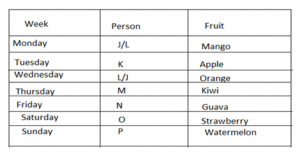Inequality Questions asked in Bank exam - How to solve, Prepare & Tips and Tricks
What is Inequality in Reasoning?
Let us uderstand inequality with the help of an example: We
know that the result of multiplication between 5 and 3 and number 15 are equal.
Since they are equal it is an equality. In the same way, 5 × 5 ≠ 15. Here the
product of 5 and 5 is not equal to the number 15. And since they are not equal,
it is an inequality.
Why it is important for bank exams?
Inequalities is one of the topics where you can get full
marks very easily. It is a common topic for all competitive exams. We can
expect 3 to 5 questions from Inequality in every PO and Clerk level
examination.
FAQ on Inequality
Q1- How many questions asked in Bank prelims exams?
Ans. There can be 3-5 questions of Inequality in reasoning section of prelims
examination.
Q2- Are these questions asked in the Bank PO Mains exam?
Ans. No, but sometimes 3-4 questions of coded inequality ask in clerk mains
level examination.
Questions based on the inequalities of
commonly two types.
- Direct inequalities and
- Coded inequalities
Before discussing details for
solving Inequalities questions, lets check the meaning of certain symbols in
below table:–
To check the different relationship, we are presenting some different statement and conclusions in below table. From given below table you will get clear concept of relationship between two letters.
Priority of Symbols in Inequality
1. > ≥ =
For ex- If A>K≥M=O
Then, A> M and T>O
2. < ≤ =
For ex- If P<X≤V=Y
Then, P<Y and P<V
3. > < (No relation)
For ex- If Q>K<L
Then there will be no relation between Q and L.
4. > ≤ (No relation)
For ex- If O>J≤H
Then there will be no relation between O and H.
5. < > (No relation)
For ex- If F<E>Q
Then there will be no relation between F and Q.
6. < ≥ (No relation)
For ex- If D<S≥Z
Then there will be no relation between D and Z.
Either- or case
In equality it is very important condition. Mostly students
make mistakes in this condition. For clear concept we are giving example of
“either-or”
1st condition for “either-or” is both conclusions should be wrong.
2nd condition is that variables of both conclusions should be same.
Eg. :–
Statement: P≥Q=R
Conclusion: (a) P > R (b) P = R
In above example, relation between P
and R is P≥R. But both the conclusions are wrong and both have same variables.
And by combining both conclusions you will get the actual relation between A
and C which comes from statement.
2. Statement: P=Q≥R≥S=T
Conclusion I: (a)P>T (b)P=T
From the above statement it is clear that P is either equals to T or P is
greater than T ,So individually both the conclusions are wrong but by combining
them we will get that P is either greater than or equals to T (P≥T).
Conclusion II: (a) Q>S (b) Q=S
Similarly from the above statement for conclusion II we can see that there is
an either / or case between Q and S, So Q either will be greater than or equals
to S.
Complicated case of “Either-or”
Statement: H≥M≤V=K
Conclusions: (1) H<K (2) H≥K
In the above statement we cannot find the relation between H
and K. There may be three possibilities of relation between H and K.
i.e. (a) H>K (b) H<K (c) H=K
And we are getting all possibilities by combining both conclusions. So, this is
also one case of “Either-or”.
Statement: F<T≤N,F>S,M≤T<G
Conclusions: I.M≥S II. S>M
In the above question by combining the statements together we get
S<F<T≥M. So we cannot find the relation between M and S. As there can be
three possible cases: M is either greater, lesser or equals to S. In
conclusions I and II we can find all the three possible cases so the answer
will be either conclusion I or II follow.
Statement: L≥K<E≥A>F≥B
Conclusions: I.L<B II.B≤L
This is another example showing that no direct relation is found between B and
L and all the three possible conditions as L>B, L<B or L=B can be there.
So the answer will be either conclusion I or II follow.
Example of coded Inequalities
Directions (1- 3): In the following questions, the symbols
@, &, %, $ and # are used with the following meaning as illustrated below:
‘P @ Q’ means ‘P is not smaller than Q’
‘P &Q’ means ‘P is neither greater than nor equal to Q’
‘P# Q’ means ‘P is neither greater than nor smaller than Q’
‘P $ Q’ means ‘P is not greater than Q’
‘P % Q’ means ‘P is neither smaller than nor equal to Q’.
Now in each of the following questions assuming the given statements to be
true, find which of the three conclusions follow and give answer accordingly.
Q1. Statements: R @ V, V $ J, J &K
Conclusions I. K % R II. J @ R III. K % V
(a) Only I is true
(b) Only II is true
(c) Only I and II are true
(d) Only III is true
(e) None of these
S1.Ans.(d)
Q2. Statements: D % H, H @ V, V $ W
Conclusions: I. H % W II. D % V III. D % W
(a) Only I is true
(b) Only II is true
(c) Only I and II are true
(d) All are true
(e) None of these
S2.Ans.(b)
Q3. Statements: M $ T, T& J, J #N
Conclusions: I. N % M II. J % M III. M $ N
(a) Only I is true
(b) Only II is true
(c) Only I and II are true
(d) All are true
(e) None of these
S3.Ans.(c)





